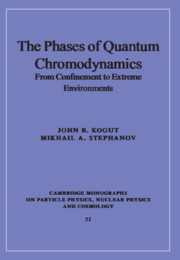Book contents
- Frontmatter
- Contents
- 1 Introduction
- 2 Background in spin systems and critical phenomena
- 3 Gauge fields on a four-dimensional euclidean lattice
- 4 Fermions and nonperturbative dynamics in QCD
- 5 Lattice fermions and chiral symmetry
- 6 The Hamiltonian version of lattice-gauge theory
- 7 Phase transitions in lattice-gauge theory at high temperatures
- 8 Physics of QCD at high temperatures and chemical potentials
- 9 Large chemical potentials and color superconductivity
- 10 Effective Lagrangians and models of QCD at nonzero chemical potential
- 11 Lattice-gauge theory at nonzero chemical potential
- 12 Epilogue
- References
- Index
9 - Large chemical potentials and color superconductivity
Published online by Cambridge University Press: 17 August 2009
- Frontmatter
- Contents
- 1 Introduction
- 2 Background in spin systems and critical phenomena
- 3 Gauge fields on a four-dimensional euclidean lattice
- 4 Fermions and nonperturbative dynamics in QCD
- 5 Lattice fermions and chiral symmetry
- 6 The Hamiltonian version of lattice-gauge theory
- 7 Phase transitions in lattice-gauge theory at high temperatures
- 8 Physics of QCD at high temperatures and chemical potentials
- 9 Large chemical potentials and color superconductivity
- 10 Effective Lagrangians and models of QCD at nonzero chemical potential
- 11 Lattice-gauge theory at nonzero chemical potential
- 12 Epilogue
- References
- Index
Summary
Color superconductivity and color–flavor locking
Lattice-gauge theory has produced unique insights and predictions for QCD at high temperature, but it has had little to say about QCD in environments rich in baryons. There are several reasons for this impasse. One of them is the fact that the fermion determinant is complex in this environment, so the standard algorithms of the subject fail. This point will be demonstrated later. Other more conventional methods, such as weak-coupling approximations, apparently apply in this environment and suggest that the theory experiences color superconductivity at asymptotically large baryon chemical potentials. There is the hope that the transition to this exotic state of matter actually occurs at a chemical potential of just a few hundred MeV. The subject of color superconductivity produces interesting conjectures for the QCD phase diagram in the T–µB plane where T is small (below a few tens of MeV) and µB is very large. In this chapter we will discuss the major points, both strengths and weaknesses, of this approach and refer the reader to the growing literature for more recent, developing events. Once lattice-gauge theory develops an algorithm that applies to this environment, these ideas will be put to stringent tests. However, for much of the rest of this chapter, we must ignore lattice-gauge theory and focus on weak-coupling methods and the BCS theory of superconductivity and its application and extensions to QCD.
- Type
- Chapter
- Information
- The Phases of Quantum ChromodynamicsFrom Confinement to Extreme Environments, pp. 236 - 279Publisher: Cambridge University PressPrint publication year: 2003



